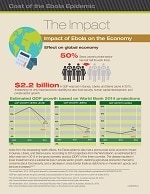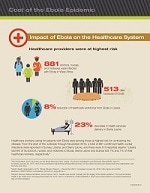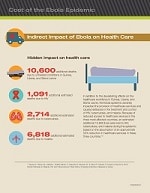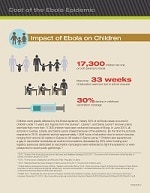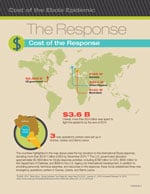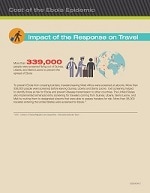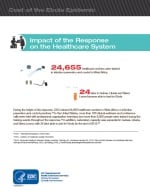Cost of the Ebola Epidemic
The 2014-2016 Ebola outbreak in West Africa has ended. Visit the Ebola Outbreak section for information on current Ebola outbreaks.
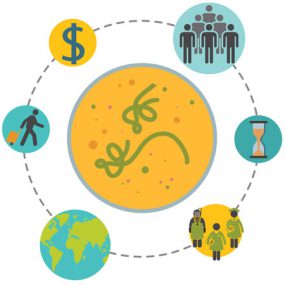

Impact of Ebola on the Economy
Aside from the devastating health effects, the Ebola epidemic also had a pronounced socio-economic impact in Guinea, Liberia, and Sierra Leone.
According to 2014 projections from the World Bank3, an estimated $2.2 billion was lost in 2015 in the gross domestic product (GDP)4 of the three countries.
The outbreak resulted in lower investment and a substantial loss in—
- Private sector growth
- Agricultural production leading to concerns about food security
- Cross-border trade as restrictions on movement, goods, and services increased5,6,7
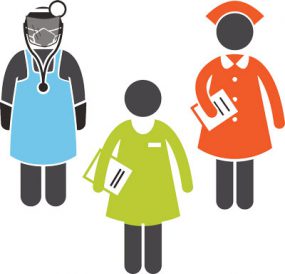
Impact of Ebola on the Healthcare System
Healthcare workers caring for patients with Ebola were among those at highest risk for contracting the disease.
From the start of the outbreak through November 2015, a total of 881 confirmed health worker infections and 513 deaths8 were reported in Guinea, Liberia, and Sierra Leone.
- Liberia lost 8% of its doctors, nurses, and midwives to Ebola
- Sierra Leone and Guinea lost 7% and 1% of their healthcare workers, respectively.9
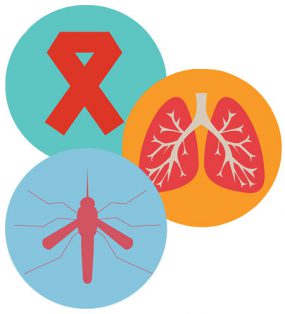
Indirect Impact of Ebola on Health Care
In addition to the devastating effects on the healthcare workforce in Guinea, Liberia, and Sierra Leone, the Ebola epidemic severely impacted the provision of healthcare services and caused setbacks in the treatment and control of other serious diseases, including:
- HIV
- Tuberculosis
- Malaria
Assuming healthcare services were reduced by 50% in the three most affected countries,10 an estimated additional 10, 600 lives were lost to HIV, tuberculosis and malaria during the epidemic.
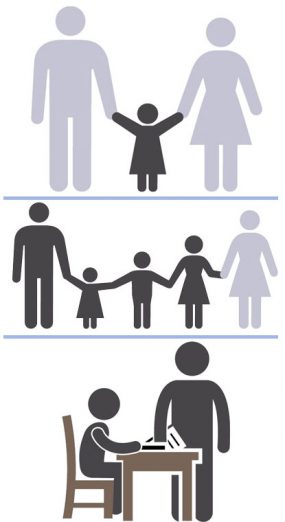
Impact of Ebola on Children
Children were greatly affected by the Ebola epidemic.
- Nearly 20% of all Ebola cases occurred in children under 15 years old.
- Recovery plans from Guinea, Liberia, and Sierra Leone estimate that more than 17,300 children have been orphaned because of Ebola.11,12,13
In June 2014, all schools in Guinea, Liberia, and Sierra Leone closed because of the epidemic.
By the time the schools reopened in 2015, students had lost approximately 1,848 hours of education due to school closures—
- Ranging from around 33 weeks in Guinea to 39 weeks in Sierra Leone.14
Children also experienced a gap in vaccination schedules as routine immunizations decreased by 30%. Vaccination campaigns were either postponed to avoid public gatherings or funding and logistics previously dedicated to these campaigns were redirected to fight the epidemic.
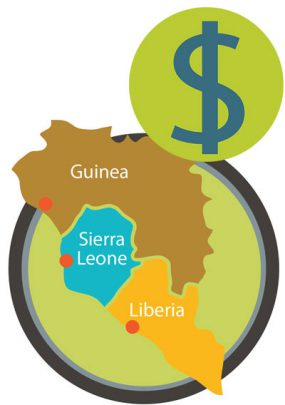
Cost of the Response
The United States, the United Kingdom, and Germany were the top donors to the international Ebola response, donating more than $3.611 billion (USD) by December 2015.16
The U.S. government allocated approximately $2.369 billion for Ebola response activities that included technical expertise, resources to the response and new emergency operations center in Guinea, Liberia, and Sierra Leone.
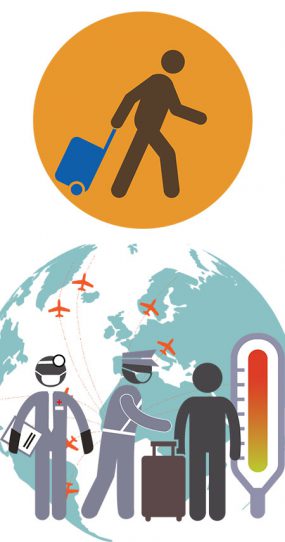
Impact of the Response on Travel
To prevent Ebola from crossing borders, travelers leaving West Africa were screened at airports. Exit screening helped to identify those at risk for Ebola and prevent disease transmission to other countries.
- More than 339,000 people were screened before leaving Guinea, Liberia and Sierra Leone.17
The United States also implemented enhanced entry screening for travelers coming from Guinea, Liberia, Sierra Leone, and Mali by routing them to designated airports that were able to assess travelers for risk.
- More than 38,000 travelers entering the United States were screened for Ebola.17
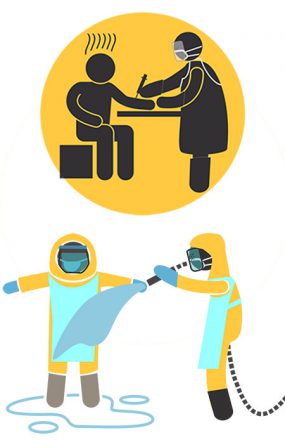
Impact of the Response on the Healthcare System
- CDC trained 24,655 healthcare workers in West Africa on infection prevention and control practices.18
- Over 160 clinical webinars and conference calls were held with professional organization members in the United States
- More than 6,500 people were trained in live training events throughout the response.19
- Laboratory capacity was expanded in Guinea, Liberia, and Sierra Leone, with 24 laboratories capable of testing for Ebola by the end of 2015.20
Download a 1-page infographic Cost of the Ebola Epidemic Cdc-pdf
Download the complete set of 8 infographics Cost of the Ebola Epidemic – Multipage Cdc-pdf
1CDC. 2016. 2014 Ebola Outbreak in West Africa – Case Counts. January 20. Accessed January 22, 2016.
2CDC. 2016. Outbreaks Chronology: Ebola Virus Disease. January 20. Accessed January 22, 2016.
3The World Bank. 2014. GDP growth (annual %)External
4GDP per capita denotes the gross domestic product/population for year 2014. Values shown in current US dollars (2015).
5The World Bank. 2015 Summary on the Ebola Recovery Plan: Sierra LeoneExternal
6The World Bank. 2015. Summary on the Ebola Recovery Plan: GuineaExternal
7The World Bank. 2015. Summary on the Ebola Recovery Plan: Liberia – Economic Stabilization and Recovery Plan (ESRP).External
8World Health Organization. 2015. “Ebola Situation Report – 4 November 2015 Cdc-pdf
9David K Evansa, Markus Goldstein, Anna Popova. 2015. “Health-care worker mortality and the legacy of the Ebola epidemic.External
10Alyssa S. Parpia, M., Martial L. Ndeffo-Mbah, P., Natasha S. Wenzel, M., & Alison P. Galvani, P. Impact of the 2014-2015 Ebola Outbreak on Malaria, HIV, and Tuberculosis in West Africa. Emerging Infectious Diseases (in press).
112015. “Guinea: Post-Ebola Socio-economic Recovery and Resilience Strategy 2015-2017.” Document of the Government of the Republic of Guinea. Accessed January 20, 2016.
122015. “The Economic Stabilization and Recovery Plan.” Republic of Liberia.
132015. “National Ebola Recovery Strategy for Sierra Leone 2015-2017.” Government of Sierra Leone.
14United Nations Development Group (UNDG) – Western and Central Africa. 2015. “Socio-Economic Impact of Ebola Virus Disease in West African Countries: A call for national and regional containment, recovery and prevention. Cdc-pdf
15UNDP. 2014. “Assessing the socio-economic impacts of Ebola Virus Disease in Guinea, Liberia and Sierra Leone: The Road to Recovery. Cdc-pdf
16USAID. 2015. “West Africa – Ebola Outbreak: Fact Sheet #6, Fiscal Year (FY) 2016. Cdc-pdf
17CDC – Division of Global Migration and Quarantine – International Border Team.
18CDC – International Infection Control Team.
19CDC – Division of Healthcare Quality Promotion.
202015. Ebola labs testing in infected African countriesExternal
